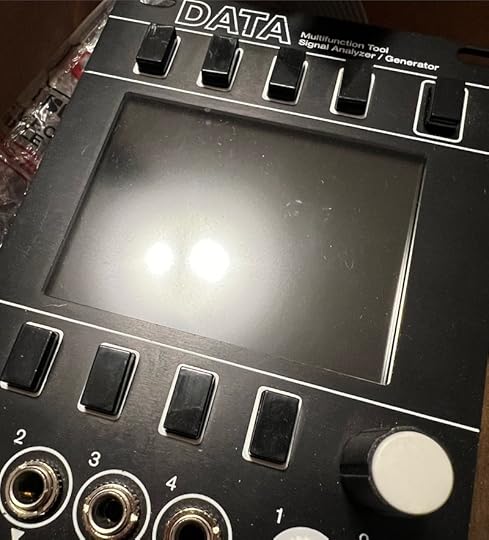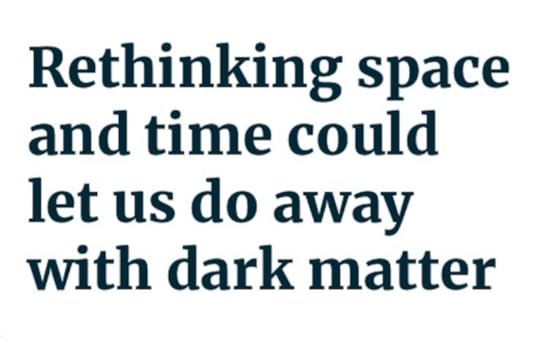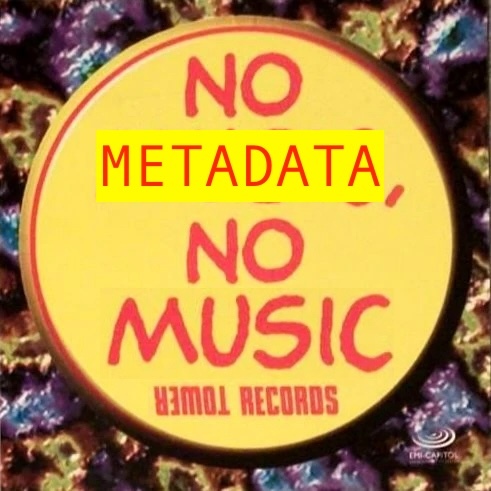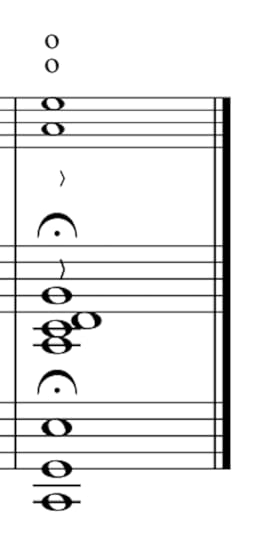Marc Weidenbaum's Blog, page 67
March 25, 2024
Signal Analyzer

Looking forward to some visual feedback in my synthesizer efforts
March 24, 2024
Kelly Moran’s Ice Breaker
This first appeared in the March 21, 2024, issue of the This Week in Sound email newsletter, also the newsletter’s 22nd Listening Post.
Just over a year into the pandemic, Kelly Moran marked most electronic music fans’ favorite annual holiday, April 14, in honor of the Aphex Twin song “Avril 14th,” with the requisite solo piano cover. She recorded her video with a camera that she set to look directly down on her keyboard, and at first all we see is the piano — even after the music starts playing. Magically, the keys move without anyone touching them, and then her hands — slender, sensual, nails gleaming colorfully — appear alongside the ghost accompaniment and flesh out her own version of the song.
It turns out that she was performing on a Disklavier, on loan from Yamaha, the same instrument on which Aphex Twin reportedly recorded the original version. “Avril 14th” appeared on his 2001 album, Drukqs; Moran’s cover marked the 20th anniversary.
More time has passed. In the years since that simple (if deceptively so) Aphex Twin experiment of hers, Moran has come to wield the Disklavier not just expertly but ferociously. She has pushed its feature set further. The instrument allows her to record parts and play along with them, and record that and play along with that. Her deep pandemic studies have yielded impossible, post-human music that is truly hyperactive, with chords that no human could accomplish on their lonesome in cadences no human could play for a prolonged period. The works are crystalline paradoxes at warp speed. It’s absolutely perfect that “Butterfly Phase,” the lead video for her forthcoming record, Moves in the Field (due out March 29), involves figure skating, because aesthetically that’s what Moran’s current music is: calisthenic, showy, muscular, and deeply competitive. (Regarding that last point, the title comes from the term in skating for the tests of a competitor’s abilities.)
Both “Butterfly Phase” and another track, “Sodalis (II),” are available as previews in advance of the full album’s release:
March 23, 2024
Scratch Pad: No Metadata, No Music
I do this manually at the end of each week: collating (and sometimes lightly editing) most of the recent little comments I’ve made on social media, which I think of as my public scratch pad. Some end up on Disquiet.com earlier, sometimes in expanded form. These days I mostly hang out on Mastodon (at post.lurk.org/@disquiet), and I’m also trying out a few others. I take weekends and evenings off social media.
▰ Having a newsletter about a specific topic is a virtuous circle. I process material that interests me in a way I wouldn’t otherwise. In turn the audience drawn to that material sends me additional items I might not have otherwise known about. Then I share some of those as well. Round and round.
Several times this week people sent me:
sentences from novels I’ve never readreferences to scientific journals I didn’t know existedsummaries of podcasts I’ve not listened toanecdotes from their own livesNow I have another issue of the newsletter to prepare.
▰ When you share an album for review consideration, here is a mind-blowing and underutilized concept: put your bio and liner notes inside the ZIP archive along with the music and the album cover.
▰ Acting on my urge to say: social media is fine but if you’ve got a focus for your interests, do yourself a favor and start a blog, even if all you do is collect your social media posts there and sometimes expand on one or another of ’em. Blogs are like ecological sentinels, the bees of the internet.
▰ “If you would like to hold without music, please press star.”
*
▰ This is pretty great. Nonesuch has nicked the Criterion Closet idea, and on top of showing the musicians pull their favorites, it also has playlists with examples of the audio. Nicely done. Four so far: pianist Tigran Hamasyan, multi-instrumentalist/singer Vagabon, pianist Timo Andres, and guitarist Mary Halvorson.
▰ Folks popping up in the Google Drive spreadsheet for the current, three-part sequence of Disquiet Junto projects, looking for tracks to turn from solos into duets, which may later become trios

▰ I love New Scientist’s take on the advice column

▰ For the moment I’m going to assume that the seeming increase in quantity of music releases (gauged by my overstuffed email inbox) and the rise of generative AI tools is a coincidence (or even me seeing patterns that aren’t there), but the parallel is striking
▰ Happy to report I was considerably less brain-dead when it came to 7th chords in guitar class this week. Bonus for the moment when my teacher played a sequence of notes and I, instinctively, played it back — Close Encounters of the Third Kind style — as a form of communicating my semi-sentience.
▰ Finding myself following the twisting paths of cables in modular synth videos to confirm they’re real and not, like the gloopy fingers common to AI-generated imagery, a tell of hallucinogenic forgery
▰ No Metadata, No Music — take it from this former Tower Records employee

March 22, 2024
Nils Frahm Retreats
This appeared in the March 21, 2024, issue of the This Week in Sound email newsletter, also the newsletter’s 22nd Listening Post.
Nils Frahm has become one of today’s great one-man bands. He travels the world with enough equipment to fill a professional recording studio, hauls it from city to city, venue to venue, sets up shop for a day or two, and then noodles live to the adoration of fans who marvel at his ambidexterity, his technological fluency, and his theatricality. Brian Eno once suggested that the studio was itself an instrument, and while what Frahm does these days with that concept is in many ways the opposite of what Eno meant, it still works.
It’s also, by all appearances, exhausting. Hence Frahm’s recent album, Day (it came out March 1), on which he retreats from overkill, returning to the simple solo acoustic piano compositions that made him something of an emo ambient heartthrob in the first place.
https://nilsfrahm.bandcamp.com/album/day
The close microphones capture his playing in all its evocative interiority: the mechanisms of the keys, the ins and outs of his breathing, and creaks in the floorboards. At one point you hear a dog barking, echoing down a hallway. The album feels like a series of wordless entries in a wordless diary from a stint in tech-addiction rehab. The intimacy is kind of intoxicating in its own way, though you do have to sort out if these are compositions or one-time noodly improvisations — and whether that matters, given how great it is to listen to.
March 21, 2024
Team-Up Marvels
This appeared in the March 21, 2024, issue of the This Week in Sound email newsletter, also the newsletter’s 22nd Listening Post.
I don’t talk about the Disquiet Junto too often in my This Week in Sound emails, but each Tuesday I do list the latest project. Today I want to mention the current project while it’s just getting underway.
For background, the Disquiet Junto is a music community I initiated back in January 2012. Each Thursday I send out a music composition creative prompt, and then participants — as many as 70 and roughly as few as 20 — record tracks responding to those instructions. When describing the Junto, I usually take a moment to paraphrase music educator and longtime Junto participant Ethan Hein, who said that the Junto is a situation where I review records that don’t exist, and then internet strangers go ahead and record them.
One of my favorite Junto experiences each year is a sequence of projects that unfold over the course of three weeks. The first week, everyone records a solo piece. The second week, musicians take the resulting solo works, pan them to the left speaker, and then record their own addition, which they pan to the right, resulting in a duet with a lot of space in between. The key thing is that, all along, these musicians know that they’re working — collaboratively and asynchronously, very much in the spirit of the Creative Commons, as I discussed as a guest on a recent episode of the Artists & Hackers podcast — toward eventual trios. The first musician leaves room for two others, and the second for an imminent third. Come the final week, which began today, March 21, participants listen to the duets from the previous week and begin to turn them into trios. This time around, they have nearly 65 to choose from, built on nearly 50 solos from the first week.
Part of what I love about these projects is the multiverse-like listening experience. As the second week proceeded, when the duets were being recorded, you could hear the same initial track in numerous settings. Here, for example, are four different duets from last week’s project, all based on a solo piece by encym:
There’s also a fifth version of the encym original, by the Australian musician bassling, on YouTube rather than SoundCloud:
Right now, musicians are turning many of those duets into trios. Already two trios have resulted from duets based on encym’s original piece:
As the three weeks proceed, these projects become a sort of listening garden of forking paths. You can listen along as the trios surface in the discussion forum at llllllll.co. The project ends on Monday night, March 25, just before midnight.
Disquiet Junto Project 0638: Center (3 of 3)

Each Thursday in the Disquiet Junto music community, a new compositional challenge is set before the group’s members, who then have five days to record and upload a track in response to the project instructions.
Membership in the Junto is open: just join and participate. (A SoundCloud account is helpful but not required.) There’s no pressure to do every project. The Junto is weekly so that you know it’s there, every Thursday through Monday, when your time and interest align.
Tracks are added to the SoundCloud playlist for the duration of the project. Additional (non-SoundCloud) tracks appear in the lllllll.co discussion thread.
These following instructions went to the group email list (via juntoletter.disquiet.com).
Disquiet Junto Project 0638: Center (3 of 3)
The Assignment: Complete a trio begun by two other musicians.
These instructions are fairly lengthy. Please read carefully.
Please note: While this is the third part of a three-part project sequence, you can participate in one, two, or all three of the parts, which have occurred over the course of three consecutive weeks.
Step 1: This week’s Disquiet Junto project is the third in a sequence that encourages and rewards asynchronous collaboration. This week you will be adding music to a pre-existing track, which you will source from the previous week’s Junto project (disquiet.com/0637). Note that you are finishing a trio: you’re creating the third part of what two previous musicians began, filling the space between them. Please keep this in mind.
Step 2: The plan is for you to record an original piece of music, on any instrumentation of your choice, as a complement to a pre-existing track. First, however, you must select the piece of music to which you will be adding your own music. There are tracks by numerous musicians to choose from. The majority, 61 at the time of publishing this post, are in this playlist:
There are also three on YouTube:
https://www.youtube.com/watch?v=vFZpzhXi7yE
https://www.youtube.com/watch?v=JhacB-FzYNQ
https://www.youtube.com/watch?v=4fMXyAfiufc
To select a track, you can listen through all those and choose one, or simply look around and select, or you can come up with a random approach to sifting through them.
When choosing a track, consider checking out the two previous projects’ discussion threads, as there may be additional information in them that could be of use, such as BPM or key signature:
https://llllllll.co/t/disquiet-junto-project-0637-right-2-of-3/
https://llllllll.co/t/disquiet-junto-project-0636-left-1-of-3/
Step 3: Record a piece of music, roughly the length of the piece of music you selected in Step 2. Your track should complement the piece from Step 2, and it should be placed dead center between the left and right stereo channels. When composing and recording your part, do not alter the original piece of music at all. To be clear: the track you upload won’t be your piece of music alone; it will be a combination of the track from Step 2 and yours.
Step 4: Also be sure, when done, to make the finished track downloadable, because it may be used by someone else in a subsequent Junto project.
Step 5: In normal circumstances, Junto projects have a one-track-per-participant limit. However, as with the preceding project that led up to this one, you can contribute more than one track this week. You can do up to three total this time. For your first, you can choose any track from the duets, no matter how many times others may have employed it. If you choose to do a second or third, you should do a track no on else has used yet (it’s understood that between when you select a duet track and finish your trio, someone else may have popped up and used it, which is perfectly fine). Throughout the project I will keep an updated list in this Google Drive document of what has been utilized:
https://docs.google.com/spreadsheets/d/1kDorIMT9j_nQQPXACYpMPe4B86T2QD5Xvv98XAOS4UE/edit?pli=1#gid=0
The goal is for many as people as possible to benefit from the experience of being part of an asynchronous collaboration. That, foremost, is the spirit of this project.
Tasks Upon Completion:
Label: Include “disquiet0638” (no spaces/quotes) in the name of your track.
Upload: Post your track to a public account (SoundCloud preferred but by no means required).
Share: Post your track and a description explanation at https://llllllll.co/t/disquiet-junto-project-0638-center-3-of-3/
Discuss: Listen to and comment on the other tracks.
Additional Details:
Length: The length is up to you. Stick close to the length of the track yours adds to.
Deadline: Monday, March 25, 2024, 11:59pm (that is: just before midnight) wherever you are.
About: https://disquiet.com/junto/
Newsletter: https://juntoletter.disquiet.com/
License: It’s required for this sequence of projects to set your track as downloadable and allowing for attributed remixing (i.e., an attribution Creative Commons license).
Please Include When Posting Your Track:
More on the 638th weekly Disquiet Junto project, Center (3 of 3) — The Assignment: Complete a trio begun by two other musicians — at https://disquiet.com/0638/
March 20, 2024
This Week in Sound: Sonic Lasers, Dulcet Hospitals, Voice Anonymization
These sound-studies highlights of the week originally appeared in the March 19, 2024, issue of the Disquiet.com weekly email newsletter, This Week in Sound. This Week in Sound is the best way I’ve found to process material I come across. Your support provides resources and encouragement. Most issues are free. A weekly annotated ambient-music mixtape is for paid subscribers. Thanks.
▰ AID UPGRADE: October 17, 2022, marked an important turning point for hearing aids, when the FDA identified a new category of over-the-counter devices in an industry long held captive to prescriptions, the cost for which can be in the thousands of dollars (U.S.). The FDA’s landmark decision has led to new, cheaper, more widely available tools for consumers, as well as to upgrades of existing devices. A new major turning point may be arriving, with the rumored addition of hearing aid features in the upcoming iOS 18 release for Apple’s iPhones, as initially noted by Bloomberg’s Mark Gurman. As Chance Miller wrote for 9 to 5 Mac, the foundations of such a move have been in place for some time: “AirPods already offer a feature called Live Listen, which launched as part of iOS 12 in 2018. This feature essentially turns an iPhone into a directional microphone, transmitting the audio captured by that iPhone to AirPods in real time. … Apple also introduced a Conversation Boost capability to AirPods Pro in 2021, which boosts mic pickup from directly in front of you, to better hear someone talking to you. A study in 2022 showed that some of these existing AirPods Pro features already compare well to much more expensive dedicated devices.”
▰ SOUND ADVICE: “Researchers at Vanderbilt University Medical Center and McMaster University in Hamilton, Ontario, have found that making medical device alarms more musical can significantly reduce perceived annoyancewithout negatively impacting the ability of research participants to learn and remember the alarms. … Hospitals have a great many auditory alerts, with prior research indicating upward of 85% of alarms require no urgent clinical action. This overabundance of noise poses patient risks, with clinicians sometimes tuning out important alerts. Modifying timbre could mitigate excessive annoyance while keeping alarms informative, the study suggests.” (Thanks, Glenn Sogge!)
▰ MINE GAMES: “If you have an audiobook coming out,” writes Brent Underwood, author of the book Ghost Town Living: Mining for Purpose and Chasing Dreams at the Edge of Death Valley, “I encourage you to think of places to record it other than a nameless studio in a major city. Your publisher might not like this idea, but your listeners will.” Underwood recorded himself reading his audiobook in one of the mines he wrote about — 900 feet underground. “It took three full days to record the book. During breaks, I walked miles of mineshafts, reading parts of the book about the mines to myself as I walked. Which, back at the microphone, brought the stories to life in a way that would have been impossible anywhere else.” There’s also a video he shot of the experience. (Thanks, Mike Rhode!)
▰ PHONON HOME RUN: “A tiny, levitated bead is at the core of an unprecedentedly bright laser that shoots particles of sound instead of light. … Just as a ray of light is made up of many particles called photons, sound consists of particle-like chunks called phonons. For several decades, researchers have been creating ‘phonon lasers’ that output these particles in a narrow beam, similar to the way optical lasers emit photons.” Per New Scientist, researchers at Hunan Normal University in China have “enhanced the laser’s ‘brightness’ – the amount of power it delivered at each phonon frequency – tenfold, as well as making its beam tighter and helping it last longer.” Due to phonons moving with less disruption through liquids than do photons, “they could be more effective than conventional lasers for imaging watery tissues in biomedicine or in some deep-sea monitoring devices,” according to Hui Jing, a co-author of the research.
▰ GLOBE TROTTER: The Sphere in Las Vegas apparently isn’t just about the surround visuals: “It was an event that introduced Holoplot’s proprietary 3D audio-beam-forming and wave-field synthesis technology—which provides headphone-quality, personalized audio to every seat—to a literally and metaphorically massive stage,” per Fast Company. “That was just one of the several projects in the past year that have showcased the Berlin-based company’s impressive ability to manipulate sound to improve the experience of listening to music.”
▰ VOICES CARRY: MIT postdoc Nauman Dawalatabad talks about potential positive uses of the technology also credited with troubling deepfakes: “Beyond the realm of creativity, where voice conversion technologies enable unprecedented flexibility in entertainment and media, audio deepfakes hold transformative promise in health care and education sectors. My current ongoing work in the anonymization of patient and doctor voices in cognitive health-care interviews, for instance, facilitates the sharing of crucial medical data for research globally while ensuring privacy. Sharing this data among researchers fosters development in the areas of cognitive health care. The application of this technology in voice restoration represents a hope for individuals with speech impairments, for example, for ALS or dysarthric speech, enhancing communication abilities and quality of life.”
▰ QUICK NOTES: Havana ‘Nother Look: Research into the brains of those who reported suffering from so-called Havana Syndrome show “no clinical evidence for the mystery condition.” ▰ Hum a Few Bars: YouTube continues to roll out a feature that identifies songs when users hum them. ▰ Making Sense: Marjorie Van Halteren unpacks poetic work of artist Andy Slater originally published in McSweeney’s: “It satisfies the quest for an approach to audio disconnected from image-‘splaining slavishness to format,” she writes. “It’s completely untethered from a listener’s second guessing, yet utterly compelling.” I love this idea of “image-‘plaining.” ▰ Shriek of the Week: The latest is that of the nuthatch: “They whistle, and chitter, and whisper. But their loud ‘dweep dweep’ call is one of the easiest to latch on to.” ▰ Sea Trek: A scientific deep dive into how noise pollution impacts whale migration — also, there’s a Scientific American podcast episode about the “anatomical workings” behind whale song. ▰ Audi-phile: Aside from a steering wheel, there are no physical hand controls on the Audi Q6 e-tron car: “it’s touchscreen or talking only.”
March 19, 2024
On the Line: Egan, Burnside, Whitehead
That is from The Candy House, Jennifer Egan’s excellent sequel to her novel A Visit from the Goon Squad. The bit about how the speaker is “a guy who knows how to measure silences” is a call back to a bit in Goon Squad when the younger version of this character kept track of songs with pauses in them. Here, older and maybe a little wiser, that character finds additional (and painful) meaning in silence.
. . .
"I stood out in the road, by Brewster’s Yard,and waited for a ghost, since ghosts were true,a pair of Clydesdales pressing to the fenceto listen: rain; the music of the spheres;or else, those calls I knew, from other worlds,the wind across the sands, a whimbrel’s cry."That is from one of two poems by John Burnside published in the March 21, 2024, edition of the London Review of Books. I didn’t know what a “whimbrel” was before I read this. I enjoyed the comprehension void before I filled it with a simple Google search, during which the word could have referred to anything at all. It’s nothing special, but I won’t say what a “whimbrel” is so you, too, can — if you also don’t know — take a pause before doing the search yourself.
. . .
“Out of the Zenith hi-fi shook crazy saxophone stuff from the Village. Freddie could have identified who was playing, and on what basement bebop nights he'd seen them, but whenever Carney heard those sounds he felt trapped in a room of lunatics.”That is from the novel Harlem Shuffle by Colson Whitehead, whom I had not gotten around to reading until now. It’s a great book, and there’s a lot packed into those two sentences, key among the data: (1) the identification of the make of hi-fi relates the main character’s job as a furniture salesman, a form of employment that begins as background information but comes to serve as a filter for how he processes the world around him, and (2) the notion of jazz as being like something from “lunatics” is a marker of a cultural divide between that character, who is Black, and certain aspects of the culture in which he was raised. (I’ve been on a novel-reading tear. Harlem Shuffle was my eighth in 2024. Reading is a form of writing procrastination that sort of doubles as research.)
Sound Ledger: Go-karts, SoundHound, leaf blowers
100: Number of noise complaints in Tokyo in 2023 due to go-karts
346: Percentage return to holders of SoundHound shares since start of 2024
2028: The year Portland, Oregon’s leaf blower prohibition goes into full effect
Sources: Go-karts: japantimes.co.jp. SoundHound: forbes.com. Portland: portland.gov




